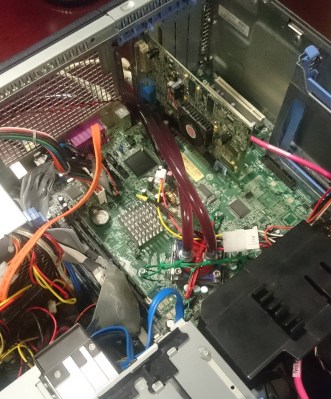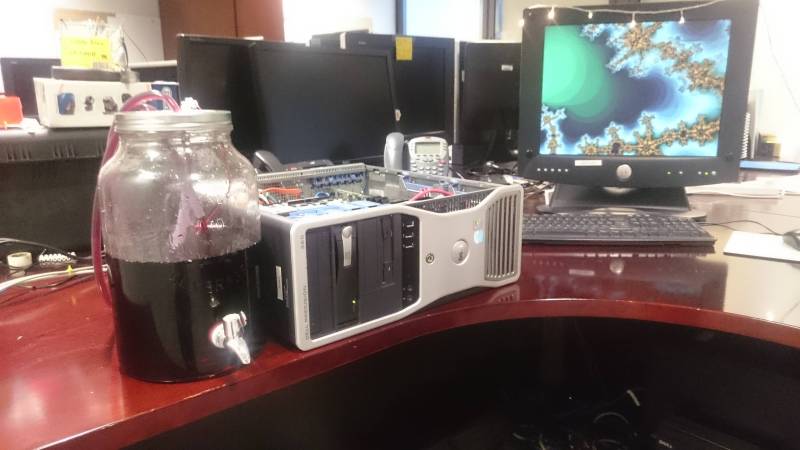Now, over the holiday season there seems to be a predilection towards making merry and bright. As many an engineer and otherwise are sure to note, fine alcohols will facilitate this process. One such warm holiday beverage is mulled wine; there are many traditions on how to make it, but a singular approach to preparing the beverage would be to re-purpose an old PC and a CPU liquid cooling unit into a mulled wine heating station.
Four years ago, [Adam] found himself staring at a pile of mostly obsolete PCs in his IT office and pondering how they could be better used. He selected one that used a power-hungry Pentium 4 — for its high heat output — strapped a liquid cooling block to the CPU and pumped it full of the holiday drink. It takes a few hours to heat three liters of wine up to an ideal 60 Celsius, but that’s just in time for lunch! The Christmastime aroma wafting through the office is nice too.
 For when the warmer months roll around, you can always keep yourself cooled down with a makeshift air conditioner by cycling liquid cooling tubes through a handily placed beer fridge. Keep your PC cool too by pulling a Georgia Tech and running the coolant through channels cut directly into the chip.
For when the warmer months roll around, you can always keep yourself cooled down with a makeshift air conditioner by cycling liquid cooling tubes through a handily placed beer fridge. Keep your PC cool too by pulling a Georgia Tech and running the coolant through channels cut directly into the chip.
[Thanks for the tip, pedroumbelino!]















Yea.. this is garbage. Sorry.
it’s some sort of hack tho
Agree, it’s one of those geek gags, funny to pull off in the office but not so funny when reading about it on the internet.
Guess you just had to be there…
Oh! A geography joke :)
But yeah, the article is just full of bad ideas…
This is better: http://web.archive.org/web/20120308141335/http://www.exaflop.org/docs/x86still/
Much more practical approach : https://www.youtube.com/watch?v=Bw2p-Dmn48U
Are those heatsink blocks food-grade???
Probably not…
Do they use any lead soldered joints?
Sulfates in wines and beers have a tendency to passivate any active metal they come into contact with.
I thought the suspected main cause for insane Roman emperors of the Caligula variety was the lead compound red glaze used for imperial crockery. In particular, wine goblets.
The Romans sweetened their wine with concentrated grape juice. They boiled down the grape juice in lead containers, producing lead acetate, which made it even sweeter than just concentrating the sugar.
Having seen them full of algae I’m wondering whether it was cleaned properly first.
Nobody cares, wine is yeast poop… which then kills it and every other organism… fruit marinaded in micro-organisms that suffocated in their own excrement… sometimes this makes it cloudy and they improve it by adding fish guts… and this is all after the grapes might have been stomped in the traditional manner by sweaty peasant feet.